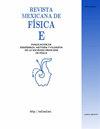Heating up a lantern with a tealight candle
Q4 Social Sciences
引用次数: 0
Abstract
This paper provided physics principles and a method to heating up a lantern with a tealight candle, so it reaches 2.5 m within the shortest time. The experiments aimed to determine optimal parameters in filling paper lanterns with hot air and the ideal shape of lanterns that would travel most quickly in a vertical direction. Hot air from burning a 28-wick candle was directed through a heat transfer system to fill the lanterns. The small ellipsoid lantern required the shortest time. This problem is suitable as a platform for STEM education approach on topics of convection, buoyancy and drag force.用茶灯蜡烛加热灯笼
本文介绍了用茶灯蜡烛加热灯笼的物理原理和方法,使其在最短时间内达到2.5米。实验旨在确定用热空气填充纸灯笼的最佳参数,以及在垂直方向上行进最快的灯笼的理想形状。来自燃烧28芯蜡烛的热空气被引导通过传热系统来填充灯笼。这个小椭球灯需要最短的时间。这个问题适合作为对流、浮力和阻力主题的STEM教育方法的平台。
本文章由计算机程序翻译,如有差异,请以英文原文为准。
求助全文
约1分钟内获得全文
求助全文
来源期刊

Revista Mexicana De Fisica E
社会科学-科学史与科学哲学
CiteScore
0.80
自引率
0.00%
发文量
14
审稿时长
>12 weeks
期刊介绍:
The Revista Mexicana de Física (Rev. Mex. Fis.) publishes original papers of interest to our readers from the physical science com unity. Language may be English or Spanish, however, given the nature of our readers, English is recommended. Articles are classified as follows:
Research. Articles reporting original results in physical science.
Instrumentation. Articles reporting original contributions on design and construction of scientific instruments. They should present new instruments and techniques oriented to physical science problems solutions. They must also report measurements performed with the described instrument.
Reviews. Critical surveys of specific physical science topics in which recent published information is analyzed and discussed. They should be accessible to physics graduate students and non specialists, and provide valuable bibliography to the specialist.
Comments. Short papers (four pages maximum) that assess critically papers by others authors previously published in the Revista Mexicana de Física. A comment should state clearly to which paper it refers.
 求助内容:
求助内容: 应助结果提醒方式:
应助结果提醒方式:


